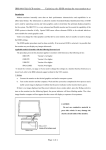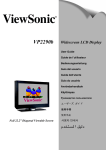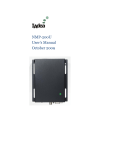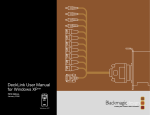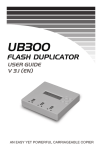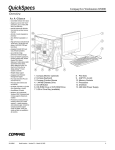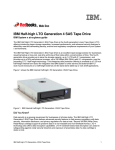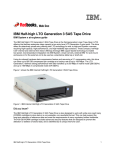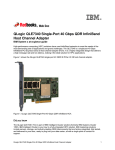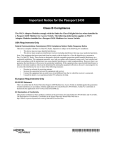Download Lenovo 9503-DG5 User's Manual
Transcript
T221 installation & system attachement information Model recommendation The primary consideration, for choosing either the T221 model DG3 or DG5 is the rate at which it is desired to display image changes. Internal frame buffers within the T221 ensure that the panel is always refreshed at a suitable rate (41Hz in the DG3, 41-48Hz in the DG5); however bandwidth and I/O considerations on the DVI interface mean that the frame buffers may be updated with new data at a slower rate. For many applications this isn’t an issue; however some applications require a higher rate so that motion or data changes are presented as quickly and smoothly as possible. The following table summaries the recommended T221 model and graphics card(s) depending on the preferred update rate. Image motion characteristic T221 Typical Applications Primarily static 2D 3D Video Smooth & life-like Document version 1.0 Office Applications Publishing Virtual Galleries & Museums Digital Photography Minimum Screen Update Rate Model EDID 13Hz DG3/5 29 20Hz DG3/5 29 24Hz DG5 02 48Hz DG5 06 Engineering & Modeling Image analysis (roaming, windowing, leveling) Video Creation Page 1 Firmware level IBM Supported Graphics Cards (NVIDIA) FX1100 FX1300 DG3 – 4.0 FX1100 FX1300 DG5 – 4.3 FX3000 FX3400 FX3000 FX3400 9/1/2004 Graphics cards • IBM certified graphics cards o AGP NVIDIA Quadro FX 4000 (special bid only) NVIDIA Quadro FX 3000 NVIDIA Quadro FX 2000 (special bid only) NVIDIA Quadro FX 1100 (supercedes the FX 1000) NVIDIA Quadro4 980 XGL o PCI-express NVIDIA Quadro FX3400 NVIDIA Quadro FX1300 o PCI NVIDIA Quadro FX 600 (special bid only) The above cards are only supported when purchased as part of a standard or special bid model of A Pro, M Pro or Z Pro IntelliStations. Possible differences in video BIOS and/or device drivers mean that non IBM versions of these cards may not operate with the T221 as expected • IBM certified graphics cards (EOL) o AGP NVIDIA Quadro4 900 XGL ATI FireGL4 Supported on earlier, standard M Pro or Z Pro IntelliStation models. Possible differences in video BIOS and/or device drivers mean that non IBM versions of these cards may not operate with the T221 as expected • Other, non-IBM certified graphics cards It is possible to attach the T221 to other graphics cards, however IBM support cannot be provided for all possible options. The suppliers of the following cards claim to support the T221; they should be contacted direct for further information o PCI Matrox HR256 Document version 1.0 Page 2 9/1/2004 Installation It's important to use the correct graphics card BIOS & device driver level when attaching the T221 When not pre-loaded, these are available from the IBM technical support web site (see http://www1.ibm.com/support/docview.wss?rs=0&q=9503&uid=psg1MIGR-39635) or the card supplier's support site and are summarized below Graphics card NVIDIA Quadro FX 3400 NVIDIA Quadro FX 1300 NVIDIA Quadro FX 4000 NVIDIA Quadro FX 3000 NVIDIA Quadro FX 2000 NVIDIA Quadro FX 1100 NVIDIA Quadro FX 600 NVIDIA Quadro4 980 XGL NVIDIA Quadro4 900 XGL ATI FireGL4 BIOS Standard Standard Standard Standard Standard Standard Standard 4.28.20.19.15 (IBM) 4.25.00.29.25 (IBM) 1.26 (IBM) Device driver (minimum level) Windows XP Windows 2000 Linux 61.76 (IBM) 61.11 (NVIDIA) 6.12.10.2090 (IBM) 1.9.16 (ATI) Note: The above device driver levels are the minimum required, it is generally advantageous to use the latest level available. Configuration The input flexibility offered by the T221, allows it to be driven in a number of different ways. There are a total of 4x single-link DVI inputs, however, operation from a single DVI input as a single monitor with a single desktop is the most simple and is typical of industry standard monitor attachment. The bandwidth of a single-link DVI channel is limited to a maximum pixel clock frequency of 165MHz, for the T221’s 3840x2400 resolution, this corresponds to an update rate of 13Hz Note: Internal frame buffers in the T221 retime the input data and display it at a fixed 41Hz (for the DG3) or 41-48Hz (for the DG5). By driving more than one input, the update rate can be increased. This is summarized below. Document version 1.0 Page 3 9/1/2004 T221 Model Inputs Internal panel refresh rate Main high resolution modes (recommended) 9503-DG3 Single-link DVI (each, max 4) - 165MHz pixel clock limit - 495MB/sec (24bit RGB) 9503-DG5 Single-link DVI (each, max 4) - 165MHz pixel clock limit - 495MB/sec (24bit RGB) 41Hz Dual-link DVI (1x), via converter box - 330MHz pixel clock limit - 990MB/sec (24bit RGB) 41-48Hz 1x DVI input = 3840x2400@13Hz 2x DVI input = 3840x2400@20Hz 4x DVI input = 3840x2400@41Hz Dual-link DVI modes 1x DVI input = 3840x2400@24Hz Single-link DVI modes 1x DVI input = 3840x2400@13Hz 2x DVI input = 3840x2400@20Hz 2x DVI input = 3840x2400@24Hz 4x DVI input = 3840x2400@48Hz Document version 1.0 Page 4 9/1/2004 Single monitor configurations. 1. Single monitor, single-link DVI (13Hz) T221 (9503-DG3/5) 3840x2400@13Hz Single-link DVI Single-link DVI not connected NVIDIA Quadro4 980XGL NVIDIA Quadro FX1000 NVIDIA Quadro FX3000 IntelliStation M/Z-Pro Driver level Graphics cards T221 EDID Update rate Desktop As per minimum level As per supported list 029 (default) 13Hz Single 2. Single monitor, twin single-link DVI (20Hz) T221 (9503-DG3/5) 3840x2400@20Hz Single-link DVI Single-link DVI NVIDIA Quadro4 980XGL NVIDIA Quadro FX1000 NVIDIA Quadro FX3000 IntelliStation M/Z-Pro Driver level Graphics cards T221 EDID Update rate Desktop As per minimum level As per supported list 029 (default) 20Hz Single (horizontal span via NVIEW utility) Dual view (extend desktop via OS) Document version 1.0 Page 5 9/1/2004 3. Single monitor, twin single-link DVI (24Hz, DG5 only) T221 (9503-DG5) 3840x2400@24Hz Single-link DVI Single-link DVI NVIDIA Quadro4 980XGL NVIDIA Quadro FX1000 NVIDIA Quadro FX3000 IntelliStation M/Z-Pro Driver level Graphics cards T221 EDID Update rate Desktop As per minimum level As per supported list 034 (default) 24Hz Single (horizontal span via NVIEW utility) Dual view (extend desktop via OS) 4. Single monitor, dual-link DVI (24Hz, DG5 only) T221 (9503-DG5) 3840x2400@24Hz Dual-link DVI Single-link DVI not connected NVIDIA Quadro FX3000 IntelliStation M/Z-Pro Driver level Graphics cards T221 EDID Update rate Desktop Minimum as per FX2000 or FX3000 FX2000 or FX3000 or FX4000 or FX3400 002 24Hz Single (*) Note : Dual link converter should be connected to graphics card DVI connector that locates close to AGP or close to PCI express. Document version 1.0 Page 6 9/1/2004 5. Single monitor, single+dual-link DVI (48Hz, DG5 only) T221 (9503-DG5) 3840x2400@48Hz Dual-link DVI Single-link DVI NVIDIA Quadro FX3000 IntelliStation M/Z-Pro Driver level Graphics cards T221 EDID Update rate Desktop 53.03 FX3000 or FX3400 006 48Hz Single (horizontal span via NVIEW utility) (*) Note : Dual link converter should be connected to graphics card DVI connector that locates close to AGP or close to PCI express. Multi-monitor configurations 1. Dual monitor configuration, twin single-link DVI (13Hz + 13Hz) T221 (9503-DG3/5) 3840x2400@13Hz Single-link DVI NVIDIA Quadro FX3000 Single-link DVI T221 (9503-DG3/5) 3840x2400@13Hz IntelliStation M/Z-Pro Driver level Graphics cards T221 EDID Update rate Desktop Minimum as per FX3000 FX3000 Note: other dual output cards can be used as per the supported list, however features such as OpenGL, portrait operation etc. will be restricted due to memory limitations Monitor 1 Monitor 2 029 (default) 029 (default) 13Hz 13Hz Single (horizontal span via NVIEW utility) Dual view (extend desktop via OS) Document version 1.0 Page 7 9/1/2004 2. Dual monitor configuration, single + dual-link DVI (13Hz + 24Hz, DG5 only) T221 (9503-DG5) 3840x2400@24Hz Dual-link DVI NVIDIA Quadro FX3000 Single-link DVI T221 (9503-DG3/5) 3840x2400@13Hz IntelliStation M/Z-Pro Driver level Graphics cards T221 EDID Update rate Desktop Minimum as per FX3000 or FX3400 FX3000 or FX3400 Note: other supported dual output cards can be used, however full performance (OpenGL, portrait operation etc.) will be limited due to available memory limitations Monitor 1 Monitor 2 002 029 (default) 24Hz 13Hz Single (horizontal span via NVIEW utility), Dual view (extend desktop via OS) (*) Note : Dual link converter should be connected to graphics card DVI connector that locates close to AGP or close to PCI express. 3. Dual monitor configuration, dual + dual-link DVI (24Hz + 24Hz, DG5 only) Dual-link DVI T221 (9503-DG5) 3840x2400@24Hz NVIDIA Quadro FX4000 Dual-link DVI T221 (9503-DG5) 3840x2400@24Hz IntelliStation M/Z-Pro Driver level Graphics cards T221 EDID Update rate Desktop Minimum as per FX4000 FX4000 Note: other supported dual output cards can be used, however full performance (OpenGL, portrait operation etc.) will be limited due to available memory limitations Monitor 1 Monitor 2 002 002 24Hz 24Hz Single (horizontal span via NVIEW utility), Dual view (extend desktop via OS) Document version 1.0 Page 8 9/1/2004 GUI & application optimization (Windows) The very high resolution of the T221 means that features of the graphical user interface (GUI), such as icons & fonts, become smaller. These can be adjusted through the 'display properties' window as per the following instructions. Note: Many of these settings are subjective, and some users may prefer values different than those suggested here. Also, after these settings have been made, some application programs and system dialog boxes may still not be scaled properly. For information concerning operating system graphical user interface scaling features available to application developers, please contact Microsoft. Win2000 1. Increase System Scaling Size (called Font Size) Right click on the desktop background, and select properties to bring up the display properties window. (The display properties window can also be launched by sequentially selecting start/settings/control panel/display.) In sequence, select settings/advanced/general/font size/other. Set the font percentage to 213%, by typing in this number in the highlighted box. Click OK as necessary in the following pop-up boxes and reboot. (It is necessary to reboot at this point because the following steps depend upon the font setting.) 2. Increase Mouse Pointer Sizes Launch Control Panel by sequentially selecting start/settings/control panel. Click on the mouse icon, then select in sequence Pointers/Scheme. Select Magnified from the list and click on OK. 3. Change other Windows Feature Sizes As in step 1, launch Display Properties window, and select Appearance. Select the following items and make changes according to the table. You will have to click on apply for each entry individually. Item Active Title Bar Active Window Border Caption Button Icon Icon Spacing Horizontal Icon Spacing Vertical Inactive Title Bar Inactive Window Border Menu Message Box Palette Title Scroll Bar Selected Items Tooltip Size 36 1 36 50 95 95 36 1 31 31 24 31 Font Size 8 Font MS Sans Serif 8 MS Sans Serif 8 MS Sans Serif 8 8 8 MS Sans Serif MS Sans Serif MS Sans Serif 8 8 MS Sans Serif MS Sans Serif 4. Change taskbar icon sizes. Document version 1.0 Page 9 9/1/2004 The taskbar contains a start button typically in the lower left corner, with the task bar running along the bottom of the screen. To the right of the start button are a number of quick launch icons for applications. Right click anywhere in the quick launch portion of the taskbar, that is not on an icon. A pop-up menu appears. Select view, then large. This increases the size of the quick launch icons. 5. Change Application user interface feature sizes. Some applications, such as MS Office, Lotus Suite, and others allow icon sizes and other features to be changed through user preferences dialog. If possible, choose large icons for each application. For some applications, standard accessibility options provide an easy path to increasing icon size. WinXP 1. Increase System Scaling Size (called Font Size). Right click on the desktop background, and select properties to bring up the display properties window. (The display properties window can also be launched by sequentially selecting start/settings/control panel/display.) In sequence, select settings/advanced/general/DPI setting/custom setting. Set the custom DPI setting to 213%, by typing in this number in the highlighted box. Click OK as necessary in the following pop-up boxes, exit out of display properties dialog, and reboot. (It is necessary to reboot at this point because the following steps depend upon the DPI setting.) 2. Change Windows Feature Sizes. For WinXP, many user appearance settings change automatically when the DPI setting is changed. This includes mouse pointer size. If you prefer an even larger mouse pointer, click on start, control panel, mouse icon, pointers, scheme, and set to Magnified (system scheme) or another preferred choice. Here are the default settings XP provides with DPI setting to 213% (204 ppi). Item Active Title Bar Active Window Border Caption Buttons Icon Icon Spacing Horizontal Icon Spacing Vertical Inactive Title Bar Inactive Window Border Menu Message Box Palette Title Scroll Bar Selected Items Tooltip Size 38 2 38 50 101 101 38 2 38 32 34 38 Font Size 8 Font Tahoma 8 Tahoma 8 Tahoma 8 8 8 Tahoma Tahoma Tahoma 8 8 Tahoma Tahoma 3. Change Application user interface feature sizes. Some applications, such as MS Office, Lotus Suite, and others allow icon sizes and other features to be changed through user preferences dialog. If possible, choose large icons for each application. For some applications, standard accessibility options provide an easy path to increasing icon size. Application dependent features Document version 1.0 Page 10 9/1/2004 It may be necessary to adjust application settings (or, persuade the application developers to modify the source code). The attached article from Microsoft explains this further: "How to write High-DPI Applications" by Nick Kramer msdn.microsoft.com See http://msdn.microsoft.com/library/default.asp?url=/library/en-us/dngdi/html/highdpiapp.asp Resolution Switching Utility There may still be some cases were it's better to run applications at a lower resolution for some tasks, and at high resolution for others. A Windows 2000/XP utility is available to enable 'on the fly' switching between resolutions. See http://www-1.ibm.com/support/docview.wss?rs=0&q=9503&uid=psg1MIGR-39635 for details. Color Management The T221 incorporates a brightness & color calibration facility. This enables the brightness and color characteristic of the monitor to be preset to match certain profiles. A Windows 2000/XP utility is available which enables calibration profiles to be loaded into the T221. See http://www-1.ibm.com/support/docview.wss?rs=0&q=9503&uid=psg1MIGR-39635 for details. The utility has been tested in conjunction with calibration hardware & software from GretagMacbeth and IMAGE Smiths. The IMAGE Smiths VeriLUM tool supports T221 calibration to DICOM requirements. Document version 1.0 Page 11 9/1/2004












